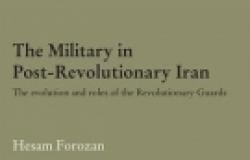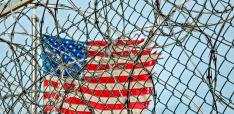Book Review: The Military in Post-Revolutionary Iran: the evolution and roles of the Revolutionary Guards

The Military in Post-Revolutionary Iran: the evolution and roles of the Revolutionary Guards by Hesam Forozan. New York and Oxford: Routledge, 2016. 255 pp, £100 hardcover 9781138913028, £34.99 e-book 9781315691640
Many years ago while I was on a research trip to Iran, I went to visit a friend who was fulfilling his military service in the Islamic Revolutionary Guards Corps. As I commiserated on his ‘bad luck’ at being conscripted into the one unit that was ideologically committed to the Islamic Revolution, he responded that it wasn’t so bad and that his initial horror had been greatly ameliorated by the realisation that the Guards were more brotherhood and network, than an organisation preoccupied with the minutiae of discipline. After all, he added, as we decamped to the pool, the regular army, would never expect anything less than a full days work. It did occur to me that his working day, on this particular day at least, had ended at 9am. At face value, this anecdote hints at an institution that is less effective as a military force than some of the more hysterical accounts of its opponents suggest. It is certainly not an orthodox military unit.
But as this excellent study by Hesam Forozan shows, it is in many ways much more than that, a military institution with a distinct political role, that effectively plays by its own rules. Forged in the heat of the revolution as a counterweight to the regular army, regarded by most revolutionaries as dangerously tainted by its association with the monarchy, the Guards, or Sepah, to use the Persian shorthand, grew from being a glorified militia with aspirations, to a parallel military organisation, during the eight year Iran-Iraq War, with an extensive logistical arm that would give it a taste for commerce. In its origins, the Sepah eschewed military hierarchy in favour of an increasingly fictional egalitarianism in which a military brotherhood – akin perhaps to religious-military orders of the Christian West – fought ostensibly for a religious ideal. They were as Forozan notes determined by the ideology of the revolution, and in turn, began to determine that very ideology. This transition is well charted by Forozan, and the book reminds us that the revolutionary guards have not been a monolithic organisation, and while certain ideals may remain constant – as only ideals can – the institution itself has changed not only to reflect new circumstances, most obviously the transition to ‘peace’ after 1988, but also in defence of its own interests. Forozan discusses this in the context of the idea of the ‘garrison state’, a conceptual framework not alien to Iranian critics of the Guards, most notably the reformist theoretician, Saeed Hajjarian, but which Forozan naturally extends and develops. For Forozan, the Guards start as ‘auxiliary’ guardians effectively in a supporting role, before moving inexorably to becoming the ‘de facto’ guardians and establishing a garrison state.
This transition is well charted by Forozan, and the book reminds us that the revolutionary guards have not been a monolithic organisation, and while certain ideals may remain constant – as only ideals can – the institution itself has changed not only to reflect new circumstances, most obviously the transition to ‘peace’ after 1988, but also in defence of its own interests. Forozan discusses this in the context of the idea of the ‘garrison state’, a conceptual framework not alien to Iranian critics of the Guards, most notably the reformist theoretician, Saeed Hajjarian, but which Forozan naturally extends and develops. For Forozan, the Guards start as ‘auxiliary’ guardians effectively in a supporting role, before moving inexorably to becoming the ‘de facto’ guardians and establishing a garrison state.
This process begins with President Rafsanjani’s attempts to institutionalise political control by merging, and arguably subsuming the Guards within the orthodox military structures of the state. This involved for example the Guards adopting ranks, but beyond such superficial changes, Rafsanjani was confronted with considerable opposition from an institution that defined itself as the guardians of a more altruistic tradition against the materialism identified with Rafsanjani and his policies. At the same time, and in stark contradiction to this seemingly high ideal, the Guards endorsed Rafsanjani’s encouragement to engage in commerce, transparent or otherwise, in order to establish an income stream and alleviate pressures on a government budget that was, post war, under strain. The result was a curious dichotomy, in which the Guards presented themselves as guardians of the nation’s revolutionary ideals, while at the same time indulging in some highly dubious commercial dealings, and a government seeking greater control, while at the same time providing them with the financial means for greater autonomy. The consequence is that by the end of Rafsanjani’s tenure, the Guards had developed into a formidable institution effectively autonomous from government and increasingly dictating the political agenda rather than protecting it.
This became most obvious in the tenure of the reformist President Khatami, where as Forozan shows, the Guards issued a blunt warning to Khatami in 1999, to rein in his more exuberant acolytes or face the consequences, a threat of military intervention that flatly contradicted the advice of the founder of the Islamic Republic, Ayatollah Khomeini, and while Khatami was able to deflect this challenge, there were no repercussions. On the contrary, the Guards began to expand on the commercial bases provided by Rafsanjani, towards the development of an autonomous military-industrial complex. Khatami tried to control this expansion by insisting that the Guards lose any tax exemption they had enjoyed but as Forozan notes [145], ‘the government’s efforts to obtain tax payments from these organisations met with little success’. On the contrary, in the waning years of the Khatami presidency the Guards launched an audacious intervention in Tehran’s Imam Khomeini Airport to prevent two Turkish telecommunication companies developing the communications infrastructure on the tendentious argument that they posed a security threat.
If the threat in 1999 marked their political coming of age then this intervention reinforced their growing domination of the economy. Under Khatami’s successor, Mahmoud Ahmadinejad, these two developments grew exponentially. Indeed by 2011, their commander, Mohammad Ali Jafari could boast [74], ‘… the Sepah is not necessarily a military institution, but in addition a security, cultural, ideological and political institution …. When the Constitution states that the Sepah must protect the revolution and its achievements, it is here that the extensive scope of the Sepah’s functions become evident and in this path we must not set constraints on its Guardianship.’
Forozan’s study is among the first to detail this transformation, in particular its increasing grip on the political economy of the country. Students of the IRGC may find few revelations in the text, and Forozan is constrained, as he notes by the availability of source material, all of which is by necessity, in the public domain. But he has done excellent work in both situating the IRGC within a coherent intellectual framework that provides some comparative utility, and perhaps more importantly, in his interrogation of the available Persian sources. There is detail in this text that many will find useful – especially on the Guards’ myriad economic interests – and he is commendably dispassionate in his analysis. This is in sum, an important study of one of the more unorthodox ‘military’ institutions of our age.
Ali M Ansari is Professor of Iranian History at the University of St Andrews.


